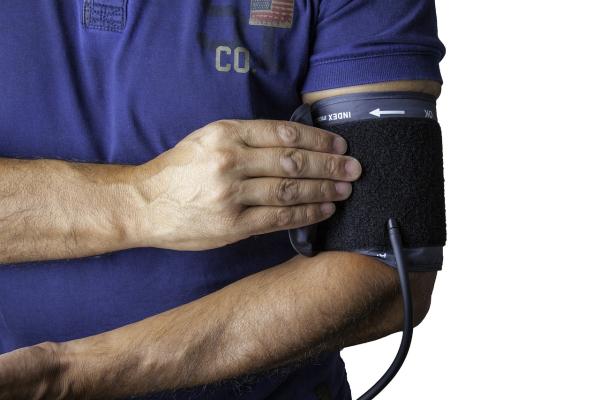Hypertension is a leading medical problem in the U.S., and except in the very extremes, it is asymptomatic. It is a disease with a specific finding. The medical term is pathognomic finding, which is an elevated blood pressure most often found during a physical examination. In the most common mechanism, a stiffening of the arteries because of atherosclerosis, makes the heart, also at risk for atherosclerosis, now termed coronary artery disease, work harder to generate these higher pressures, putting it at greater risk of failing. There are other hormonal influences as well as interactions with the kidneys that help regulate blood pressure. Hypertension is not only a problem on its own but is associated as a risk factor for cardiovascular and renal disease.
Guidelines for the diagnosis of hypertension recommend that blood pressure be monitored over 24 hours either using an automated device or home measurements to firmly make the diagnosis. The need for a 24-hour picture is because our blood pressure changes with every beat of our heart, and there are extraneous factors that influence blood pressure. The most commonly discussed of those influences is “white-coat syndrome,” where being in a medical setting makes you anxious, releasing hormones that raise your blood pressure in preparation for “fight or flee.” (Hopefully the latter) [1]
The value and pitfalls of fully automatic blood pressure devices are well known; I have reported on them in the past. However, because of concerns over cost and being cumbersome to patients and physicians, they are rarely used in the US. Home monitoring is also less likely to be used. Still, the latest study on ambulatory blood pressure and why the Washington Post writes that you might get an equally accurate picture of blood pressure at home was reported in the Journal of General Internal Medicine.
Patients with a blood pressure of 138/88 or greater, without a diagnosis of hypertension or use of hypertension medications, were identified from electronic health records. Five hundred ten entered the study, roughly half women, 80% White, mean age 50, and baseline BP 150/88. They were randomized to blood pressure measurements in clinic, at home, or using a kiosk as found in your neighborhood drug store. Then, all underwent ambulatory blood pressure measurement (ABPM), considered the “ground truth.”
When compared with ABPM, clinic measurements were lower by about 5 mmHg, home measurements were lower by 0.1 mmHg, and kiosk measurements were greater by 9 mmHg. As a result, home measurements were most in line with ABPM – but false positives were more frequently identified in the home measurements, 13.8% vs. those done in the clinic, 5.6%. Kiosk measurements were, as a practical matter, useless in clinical care.
Based on those findings, the Post, publishing on behalf of Consumer Reports, stated:
“measuring your blood pressure accurately can be tricky. In fact, when you get it taken in a doctor’s office, there’s a good chance those numbers won’t reflect your real blood pressure on an ordinary day. … But the good news is that there’s an easy and relatively inexpensive way to get an accurate picture of your blood pressure from the comfort of your own home.”
Why the best place to check blood pressure may not be a doctor’s office – Washington Post
“measuring your blood pressure accurately can be tricky.”
There is a lot of truth to that sentence, and you can find my reporting on that topic here. The WaPo article offers a litany of specific procedures,
“feet flat on the floor, your back against a sturdy chair, and your arm on a flat surface. Also, the cuff should be level with your heart and placed directly on your skin (not over your shirt), and you should empty your bladder and sit quietly for several minutes before taking the reading.”
I'm not so sure about an empty bladder or arm on a flat surface, but you get the idea few of these “procedures” take place when you see the doctor, especially the placement of a blood pressure cuff on your skin. Additionally, blood pressure devices used in clinics require annual calibration. The researchers make all these arguments to explain why clinic blood pressure measurement differed from ABPM.
The study participants had access to a “validated Bluetooth-enabled oscillometric … monitor with an appropriately sized upper-arm cuff,” a device not often available to primary care physicians. The WaPo article mentions the concern about cuff size and accuracy before referring you to a list of AMA-approved devices and the Consumer Reports ratings.
There are two points to take away. First, blood pressure measurements are snapshots; to get the picture, you need more than one or two measurements. Second, home blood pressure measurements, using validated devices and appropriate size cuffs, will be good at identifying those without hypertension, a false negative risk of about 12%, and may over-identify hypertension, a false positive risk of about 13%. Still, it does better than one or two measurements in your primary care physician's hurried examination.
But, these conclusions are based on studies involving motivated participants. The researchers asked over 9,000 participants; 45% refused, 18% couldn’t be contacted, and 9% had an arm size that did not fit blood pressure cuffs or were not hypertensive. As compared to research participants, how motivated and fastidious real-world patients are will determine how practical this approach will be.
[1] As a personal aside, even as a physician (or because of it), I am often plagued by white-coat syndrome, especially just before a procedure when I have triple-digit systolic and diastolic readings.
Source: Clinic, Home, and Kiosk Blood Pressure Measurements for Diagnosing Hypertension: a Randomized Diagnostic Study Journal of General Internal Medicine DOI: 10.1007/s11606-022-07400-z




